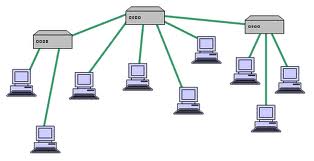Network Cabling Issues
 A major part of creating a viable network involves the installation of a cabling system. A solid cabling system is a good investment that will not only meet your current networking needs, but will last through your next-generation network as well.
A major part of creating a viable network involves the installation of a cabling system. A solid cabling system is a good investment that will not only meet your current networking needs, but will last through your next-generation network as well.
Modern Ethernet networks follow a “star topology”, where each device on the network connects its own cable to a hub. In a single room network you can use drop cables to connect each device to a hub. If your network spans an entire building, then you need to install a cabling system, and designate one or more wiring centers for your network.
Cables originate at the location of each device on the network and terminate in a wiring center. On the user end, the cable will terminate with a wall plate. In the wiring center the cable will terminate in a jack on a patch panel. Be sure to use high-quality cables that conform to established standards.
There are basically three options for connecting computers: copper wire, fiber optics and wireless technologies.
While it is possible to use fiber optics to connect PCs and printers in a LAN, fiber-optics are expensive to implement, and installation and maintenance demand a higher level of expertise. It is seldom cost-effective to use fiber optics when copper cabling can achieve 100 Mbps speed
In buildings that lack the pathways needed for cable installation, Installing a wireless hub and transmitters on each computer can be less than the cost of a cabling system; but cable installation costs less than installing wireless equipment, and has better performance.
The current standard for data cable networks is Category Five, but as labor costs for installation are much higher than the cost of the cable itself, it’s better to use the higher grade Category Six cable.
